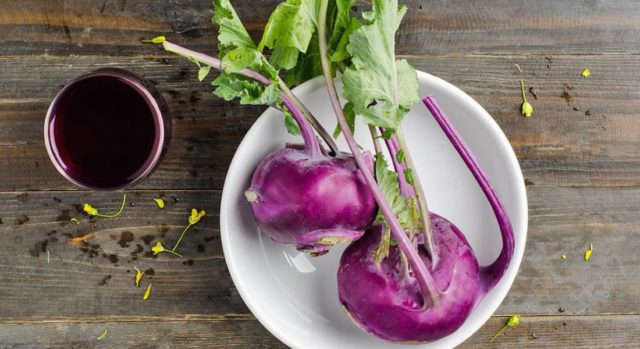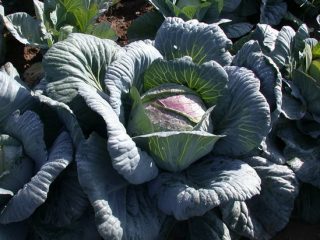Content
- 1 What is kohlrabi cabbage
- 2 Chemical composition of kohlrabi
- 3 The taste of kohlrabi cabbage
- 4 What are the benefits of kohlrabi?
- 5 Harm of kohlrabi cabbage
- 6 At what age can a child have kohlrabi?
- 7 Contraindications to kohlrabi
- 8 How to eat kohlrabi
- 9 How to use kohlrabi in traditional medicine
- 10 Kohlrabi during pregnancy
- 11 Conclusion
The health benefits and harms of kohlrabi are always individual. To understand how to use the product correctly, you need to study its composition and properties, as well as become familiar with the contraindications.
What is kohlrabi cabbage
Kohlrabi is a type of white cabbage. The name of the product literally translates as “cabbage turnip”; the nutritional value is represented by a small rounded stem with leaves. The color of kohlrabi is white, green or purple, the pulp of cabbage is very juicy.
Cabbage turnip originates from Northern Europe, and the first mentions of it can be found in documents of the 16th century. Currently, the product is consumed all over the world, and it is especially popular in Asian countries, India and China.

Kohlrabi is a vegetable similar to both cabbage and turnips.
Chemical composition of kohlrabi
Eating kohlrabi is very beneficial for health. Cabbage is rich in valuable vitamins and minerals; it contains:
- subgroup B vitamins - from B1 to B9, with the exception of B12;
- ascorbic acid - more than half the daily value;
- vitamins A, E and beta-carotene;
- nicotinic acid PP;
- silicon - over 230% of the daily norm;
- potassium, phosphorus and magnesium;
- calcium and iron;
- sodium and selenium;
- fructose and glucose;
- fatty acid;
- cellulose.
About 7.9 g of the vegetable consists of carbohydrates, another 2.8 and 0.1 g each are accounted for by proteins and fats. The calorie content of cabbage turnips is not too high - only 44 kcal per 100 g of pulp.
The taste of kohlrabi cabbage
The product has an unusual taste and resembles both a turnip and the stalk of ordinary white cabbage. But at the same time, there is no bitterness in kohlrabi, like in the stalk, so it is much more pleasant to eat it.

The taste of the vegetable is similar to cabbage stalks, but without bitterness
What are the benefits of kohlrabi?
With regular use, the product has a beneficial effect on the general condition of the body. In particular, cabbage turnips:
- has an antioxidant effect and prevents the development of tumors in the body;
- improves the functioning of the intestinal tract and helps regulate stool;
- protects the stomach from illnesses and cleanses the liver;
- removes toxins from the body, which promotes rapid weight loss;
- helps get rid of excess fluids and relieves swelling;
- has a mild sedative effect and is beneficial for stress and anxiety disorders;
- has antimicrobial and anti-inflammatory effects;
- maintains the elasticity of blood vessels and protects the heart from ailments.
Since kohlrabi contains a lot of vitamin C, the product can be consumed to protect against seasonal viruses and colds.
What are the benefits of kohlrabi for women?
Cabbage turnips are of great benefit to the female body. First of all, the product promotes rejuvenation of the body and cell renewal, helping to delay inevitable aging. Kohlrabi strengthens nails and hair, improves skin condition and slows down the appearance of the first wrinkles.
The product can be consumed for dietary purposes; cabbage very quickly normalizes metabolism and helps maintain slimness. With regular use, the product increases energy and alertness, has a beneficial effect on the quality of night sleep and fights stress.

The product helps women lose weight and improves skin condition
What are the benefits of kohlrabi for the male body?
Kohlrabi cabbage can also benefit men. Since the product stimulates the functioning of blood vessels and the heart, its use reduces the likelihood of developing heart attacks and strokes.
Kohlrabi improves blood circulation, therefore has a beneficial effect on the state of the reproductive system and increases potency. It is recommended for athletes to add cabbage to their diet; the product strengthens endurance and gives strength.
Harm of kohlrabi cabbage
Despite its numerous beneficial properties, cabbage turnips can cause harm if consumed carelessly:
- If single dosages of the product are exceeded, allergic reactions and digestive upset are possible. The daily dosage should be no more than 250 g of the product; it is advisable not to include cabbage in the diet every day.
- Eating cabbage pulp is not recommended at night.The product activates digestion and has a diuretic effect, so it can interfere with healthy sleep.
- Store-bought kohlrabi cabbage may contain nitrates in its pulp and peel. Before cooking, it is recommended to soak the cabbage in water for half an hour to remove potentially dangerous substances.

Kohlrabi can be harmful to your health if it is of low quality or if consumed at night.
At what age can a child have kohlrabi?
For children, kohlrabi vitamins may be beneficial. The vegetable will promote healthy digestion and help strengthen the child’s immune system and vascular system.
But you can offer the product to your baby only after 6 months of life. In this case, the cabbage must be heat treated - boiled or baked. The initial dosage should not exceed half a small spoon.
Contraindications to kohlrabi
For some diseases, cabbage pulp is not recommended to be consumed, since the product can cause exacerbations. Contraindications include:
- pancreatitis and stomach ulcers;
- gastritis with increased production of stomach acid;
- hypotension;
- peptic ulcer;
- individual allergy.
It is not recommended to eat kohlrabi in its pure form on an empty stomach. The product can cause heartburn, belching and irritation of the mucous membranes.

In case of acute stomach ailments, vegetables should be avoided.
How to eat kohlrabi
Before any processing, the vegetable must be peeled, and this is done like this:
- kohlrabi is washed in running water;
- cut off the top and bottom of the stem;
- Using a sharp knife, carefully remove the peel over the entire area of the cabbage down to the pulp.
You can eat cabbage turnips in different ways. First of all, kohlrabi is added to salads - the stem fruit goes well with vegetables, herbs and apples. Cabbage can also be boiled, baked and fried, stewed, processed in a double boiler and multicooker. The vegetable is added to stews and cutlets, soups and pancakes, and side dishes.

Peel kohlrabi in almost the same way as pineapple - cut off the peel from the top, bottom and sides
How to use kohlrabi in traditional medicine
The medicinal properties of the product deserve attention - cabbage turnips can be used, among other things, to treat ailments. Traditional medicine offers many recipes based on vegetables.
For cholecystitis
In case of exacerbation of cholecystitis, you can drink fresh kohlrabi cabbage juice in combination with honey. The remedy is prepared as follows:
- 2-3 small cabbage turnip fruits, peeled;
- cut into small cubes and grind in a blender;
- the resulting pulp is passed through cheesecloth, squeezing out fresh juice;
- mix the juice with 1 small spoon of honey.
It is necessary to take the remedy three times a day on an empty stomach. In total, treatment is continued for 2 weeks in the absence of negative reactions from the body.

Juice squeezed from the product helps with cholecystitis
For colds
Vitamin C and other beneficial components in the product can help with colds, runny nose and high fever. The following drink is prepared for treatment:
- 100 ml of fresh juice is obtained from fresh cabbage turnip pulp;
- mix with 100 ml of slightly warmed milk;
- add 1 small spoon of natural honey;
- add half a small spoon of onion juice.
Take the mixture up to 6 times a day, 2 large spoons at intervals of a couple of hours. Usually, only 1 day of treatment is enough for the first symptoms of a cold to subside.

Kohlrabi juice combined with honey and milk is good for colds
For the heart and blood vessels
Kohlrabi effectively strengthens blood vessels, so it is recommended to use a remedy based on the product for hypertension and a tendency to heart disease. You can prepare this drink:
- squeeze 300 ml of juice from a fresh vegetable;
- mix with 2 small spoons of grapefruit juice.
The drug is taken 4 sips twice a day; therapy should be continued for no longer than 10 days in a row.

Kohlrabi juice helps with hypertension
For pyelonephritis
The anti-inflammatory properties of kohlrabi cabbage help with kidney diseases. During an exacerbation, you can prepare a salad using the product according to the following recipe:
- wash a green apple and 150 g of kohlrabi, peel and finely chop;
- mix the ingredients in a salad bowl;
- add 1 large spoon of olive oil and herbs to taste.
You can eat a healthy salad up to 2 times a day on a daily basis.

Salad with apples and cabbage can be consumed for kidney problems
For gout
The medicinal properties of kohlrabi have a good effect on the accumulation of harmful salts in the joints. The following remedy is usually prepared:
- 250 ml of juice is obtained from a fresh vegetable;
- mix the juice with 1 large spoon of natural liquid honey;
- add some chopped walnuts.
The mixture is consumed 2 large spoons three times a day. You can continue treatment for a month in a row, after which you need to take a break.

Cabbage juice with nuts and honey is good for gout
For skin damage
For wounds, abrasions and skin irritations, you can use kohlrabi leaves. The vegetable tops must be washed thoroughly and then applied to the damaged area in whole or crushed form. The beneficial substances in the leaves will promote rapid healing of the skin and have an anti-inflammatory effect.

Vegetable tops can be applied to skin lesions
The benefits of kohlrabi for oncology
Among the beneficial properties of kohlrabi, it is customary to especially highlight its anti-cancer effect. The vegetable contains important antioxidants, including sulforaphane. This substance helps suppress free radicals, prevents the spread of malignant cells and helps protect against the development of cancer.
It is necessary to understand that cabbage turnip for cancer can only have an auxiliary effect. It is not a medicinal drug, but a healthy food product.
Including kohlrabi in the diet for the prevention and treatment of oncology is very useful, but only on the condition that traditional drug therapy is carried out at the same time. In addition, you should first consult with your doctor and make sure that there are no individual contraindications to the use of the vegetable.

If you have cancer, it is useful to use the product, but only in combination with medications
Kohlrabi for diabetes
Cabbage turnips have a low glycemic index, which is 20 units. Therefore, in case of diabetes mellitus, eating vegetables is usually allowed.Kohlrabi does not lead to a sharp increase in sugar levels and does not provoke a worsening of the condition. Glucose and fructose, which are contained in the vegetable, are well absorbed by the body.
If you have diabetes, you can eat kohlrabi in salads and in heat-treated form. The benefit of the product is that cabbage turnip strengthens the vascular walls and promotes good functioning of the pancreas. The valuable properties of the vegetable help prevent possible complications that often develop against the background of diabetes.

The vegetable has a low glycemic index, so sugar levels do not increase
Kohlrabi during pregnancy
Since cabbage turnips contain a huge amount of vitamins and minerals, they can be beneficial while you are expecting a baby. When a woman consumes the product, the risk of developing vitamin deficiency is reduced.
Kohlrabi helps fight swelling, which often occurs in later stages, and prevents constipation, which also often affects pregnant women. B vitamins in the product contribute to the healthy formation of the baby's nervous system.
But when breastfeeding, it is better to remove kohlrabi from the diet. It is allowed to return the vegetable to the menu only 3 months after giving birth, and the product should only be consumed in processed form. Cabbage turnips contain a lot of coarse dietary fiber and can cause colic in a baby, so it should be introduced into the diet of a nursing mother with great caution.

Pregnant women and nursing mothers can consume the product boiled
Conclusion
The health benefits and harms of kohlrabi accompany each other - the vegetable can support the body or cause harm. With moderate use and no contraindications, the product will improve health and have a therapeutic effect. But kohlrabi should be introduced into the diet in small quantities.








